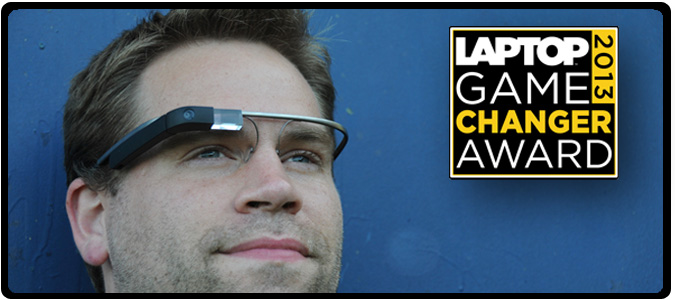Google Glass - Game Changer Award Winner 2013
The wearable-tech market is expected to boom within the next few years, and devices like Google Glass are leading the way. While it may be a while before you see people walking down the street wearing heads-up displays, Google Glass is among the first such gadgets to spark the interest of the masses.
"It's a way of interacting with the device that we're just not used to," said Ben Arnold, an industry analyst with the NPD Group who covers technology trends. "Even with smartwatches, we've all had watches before, but we've never had information right in front of our face. I think that new experience, and probably the applications that come with that, are totally new propositions for consumers."
You can't buy Google Glass just yet, but the Google Glass Explorer edition has been available for developers, and those in the program, for several months. Google's heads-up display does exactly what the term implies: It situates a small, transparent display just above your eye so that you can receive notifications, alerts or phone calls right in your line of vision.
MORE: Top 10 Features of Google Glass
Just as important, Glass has the potential to revolutionize photography. You can shoot first-person videos and images as opportunities arise, capturing the subject from the user's vantage point. You don't even need to press a button. Just say, "OK Glass, take a picture."
Not only does Google have the media and tech-savvy consumers buzzing, but it has motivated competing companies to delve deeper into wearables. While Samsung is rumored to be working on a heads-up display of its own, smaller brands that have been working on wearable tech for quite some time are readying their own products. The Vuzix M100, Oculon Smart Glasses, GlassUp and Telepathy One are just some Glass alternatives that hope to steal the spotlight.
Google, however, has the upper hand because its device naturally integrates tightly with Gmail, Google Now and the search-engine giant's other services.
Sign up to receive The Snapshot, a free special dispatch from Laptop Mag, in your inbox.
"A big part of it is what Google brings to the table and the enormous ecosystem of applications and services," Arnold said. "A Google wearable product can tap into that."
The heads-up display faces the inherent challenge of being more pronounced and conspicuous than the smartwatch. This is an obstacle that Google has attempted to address by making the eyepiece as small as possible. The band itself is also available in a range of colors, but that hasn't stopped detractors from labeling Glass as a toy for wannabe cyborgs.
“I know a lot of people kind of bash Glass for being worn on your face and being somewhat intrusive, but I think the total opposite," Arnold said. "I think it's got a fairly minimal impact on your face, and there's a lot to be said about the form factor."
MORE: Google Glass—What Explorers Love and Hate
The real challenge for Glass is the privacy concerns and regulations that come with it. The idea of everyday consumers walking around with wearable cameras is causing controversy long before a consumer version of the product ships. A bar in Seattle called 5 Points banned Glass as soon as the Explorer editions began shipping (though it was at least partly a PR stunt), and a woman in California was recently issued a ticket for driving while wearing Glass.
"I feel like the privacy concerns and the distracted-driving issues need to be figured out first," Arnold said. "There are some of these speed bumps or roadblocks that we have to get through before people are really comfortable with these products."
Glass isn't likely to launch until late 2014, but it's gaining interest now because it is the most exciting product in a wearable computing market that many are heralding as the next big wave of innovation. Market research firm Berg Insight estimates the wearable tech industry will hit 64 million shipments by 2017.
"Probably the most important [factor] is the growth of mobile, app ecosystems and consumers really getting used to being always connected to the Internet," Arnold said. "Consumers need to get psychologically used to having any kind of information on call at the touch of a button, so I think that's a very important step in getting into wearables."
Game Changer Award Winners 2013
SMARTPHONE: Motorola Moto X
The Moto X is the first smartphone that lets you perform voice commands without touching your device.
CAMERA: Nokia Lumia 1020
The Lumia 1020 packs a 41-megapixel sensor and lets you zoom in on photos after you take them.
TABLET: Amazon Kindle Fire HDX
Amazon has reinvented tech support with the Mayday button on its new tablet.
GAMING: Oculus Rift
This jaw-dropping virtual reality gaming headset literally puts you inside the action.
PC PERIPHERAL: Leap Motion
Leap Motion can read your hand gestures for doing everything from gaming to exploring the universe.
CARRIER: T-Mobile
T-Mobile has shaken up the wireless world by nixing contracts and making phone upgrading easy.
SMARTWATCH: Pebble
Pebble is taking smartwatches mainstream with an e-paper display, useful apps and a low price.
APP: Vine
Vine is a whole new way to communicate and tell stories via 6-second videos that are a cinch to share.
ENABLING TECHNOLOGY: Intel Bay Trail
Intel's powerful but efficient new CPU gives 2-in-1 tablets and laptops more speed and battery life.



